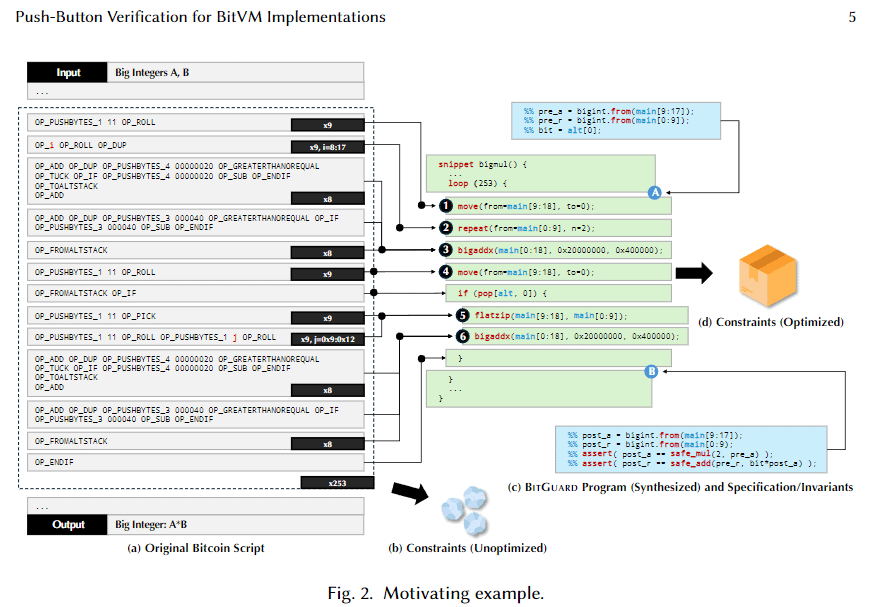Today I read a paper on 𝗙𝗼𝗿𝗺𝗮𝗹 𝗩𝗲𝗿𝗶𝗳𝗶𝗰𝗮𝘁𝗶𝗼𝗻 𝗳𝗼𝗿 𝗕𝗶𝘁𝗩𝗠 tweeted by Professor Yufeng @captain8299. I used GPT-4 to look up many technical terms, which were quite obscure and difficult to understand. Let me summarize the essence of the paper.
Currently, major #BTC ecosystem projects are eager to unlock the $1.3 trillion of dormant assets in BTC, hoping that #BTCFi can unify the landscape and bring abundant incremental funds and liquidity to Web3. However, the scalability and processing speed of BTC have always been significant challenges. #BitVM is currently an emerging BTC L2 solution aimed at expanding Bitcoin's functionality through off-chain computation and on-chain verification. However, due to the limitations of Bitcoin's scripting language (such as the lack of support for loops and recursion), the programming process implemented by BitVM is complex and prone to errors, necessitating a reliable verification method.
The essence of this paper is to demonstrate and complete the formal verification of BitVM (𝗙𝗼𝗿𝗺𝗮𝗹 𝗩𝗲𝗿𝗶𝗳𝗶𝗰𝗮𝘁𝗶𝗼𝗻 𝗳𝗼𝗿 𝗕𝗶𝘁𝗩𝗠), while proposing "Push-Button Formal Verification for BitVM," a method for automating the formal verification of BitVM with a single click.
To explain the concept of formal verification in simpler terms, it is a method that uses mathematics and logic to prove whether the behavior of a system or program conforms to specific specifications. It is primarily used to ensure the correctness of software or hardware systems, especially in fields with high safety and reliability requirements (such as finance, aerospace, cryptocurrency, etc.).
For BitVM, the goal of formal verification is to validate the security and accuracy of the code through mathematical reasoning and automated tools. This verification can reduce developers' reliance on code testing and manual checks, allowing the behavior of the code to be rigorously proven. This step is particularly important for the Bitcoin ecosystem, as any error in the Bitcoin network can have far-reaching consequences and potentially lead to significant financial losses.
The paper proposes three solutions:
• It introduces a register-based domain-specific language (DSL) that can abstract complex stack operations, making it easier for developers to reason about the correctness of the program.
• It introduces a formal computational model to capture the semantics of BitVM execution and Bitcoin scripts, thereby building a rigorous verification foundation.
• It employs a program called "Counterexample-Guided Inductive Synthesis (CEGIS)" to help convert Bitcoin scripts to DSL, achieving efficient verification without sacrificing accuracy.
It's okay if you don't understand the above solutions; I only have a partial understanding myself. But as long as you know its verification methods and effectiveness, that's enough.
Verification method: By designing loop invariant predicates, the DSL can effectively handle the unfolding calculations of simulated loops, reducing the complexity of the formulas. Hoare logic is used to verify code correctness, transforming the code logic into manageable constraints, thereby simplifying the verification process.
Conclusion: #Nubit has proposed a method and tool for one-click automated formal verification of BitVM and introduced an innovative register DSL that can abstract and simplify complex stack operations, significantly improving verification efficiency. This tool is of great significance for the security of blockchain smart contracts, effectively identifying and preventing potential vulnerabilities, ensuring the safety of BitVM!
This paper was led by Nubit, Professor Yufeng, in collaboration with BitVM founder Robin from @ZeroSync, as well as @AlpenLabs, @citreaxyz, and Domo from @L1Fxyz, the founder of BRC20.
If anyone is interested, feel free to engage in discussions with these experts. Grateful for the contributions made to the BTC ecosystem! 🙏

免责声明:本文章仅代表作者个人观点,不代表本平台的立场和观点。本文章仅供信息分享,不构成对任何人的任何投资建议。用户与作者之间的任何争议,与本平台无关。如网页中刊载的文章或图片涉及侵权,请提供相关的权利证明和身份证明发送邮件到support@aicoin.com,本平台相关工作人员将会进行核查。




